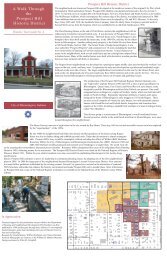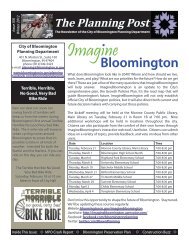Peak Oil Task Force Report - City of Bloomington - State of Indiana
Peak Oil Task Force Report - City of Bloomington - State of Indiana
Peak Oil Task Force Report - City of Bloomington - State of Indiana
You also want an ePaper? Increase the reach of your titles
YUMPU automatically turns print PDFs into web optimized ePapers that Google loves.
The <strong>City</strong> can do much to encourage and increase<br />
rainwater capture for use on lawns and gardens.<br />
Following the lead <strong>of</strong> other communities, the <strong>City</strong><br />
should:<br />
• Provide rain barrels to community members<br />
at a reduced cost, much the way it did when it<br />
<strong>of</strong>fered compost bins at a reduced rate (in<br />
cooperation with the Center for Sustainable<br />
Living). It is estimated that a 55 gallon rain<br />
barrel can save approximately 1,300 gallons <strong>of</strong><br />
water in peak summer months; 73<br />
• Implement a rain barrel rebate program; 74<br />
• Require greywater and ro<strong>of</strong>water catchment<br />
for new development as part <strong>of</strong> the <strong>City</strong>’s<br />
Unified Development Ordinance (UDO).<br />
Currently, the UDO provides incentives for the<br />
use <strong>of</strong> greywater, but does not require it. 75<br />
The <strong>City</strong> might look to Tucson, Arizona – the<br />
first city in the US to require rainwater<br />
harvesting for landscaping use. In Tucson, effective June 1, 2010, 50% <strong>of</strong> a<br />
commercial property’s irrigation water must be supplied from rainwater. In<br />
addition to cisterns, the regulations allow berms and contoured slopes to be used to<br />
direct rainwater to trees and landscaped areas; 76<br />
• Require bio‐swales and/or permeable paving for any new development; and<br />
• The <strong>City</strong> should lead by example by installing cisterns and rain barrels to provide for<br />
its own landscaping needs.<br />
73 U.S. E.P.A., What is a Rain Barrel? http://www.epa.gov/Region3/p2/what‐is‐rainbarrel.pdf<br />
74 For example, see the cistern rebate program <strong>of</strong>fered by James, Virginia<br />
http://www.bewatersmart.org/RebatePrograms/rainbarrelrebateprogram/FAQ.html#rainbarrel<br />
75 §20.05.049, <strong>Bloomington</strong> Municipal Code. http://bloomington.in.gov/green‐building‐incentives<br />
76 http://www.ci.tucson.az.us/agdocs/20081014/oct14‐08‐564a.pdf<br />
<strong>Report</strong> <strong>of</strong> the <strong>Bloomington</strong> <strong>Peak</strong> <strong>Oil</strong> <strong>Task</strong> <strong>Force</strong><br />
Commercially sized cistern at the Chicago Center for<br />
Green Technology. Source: Abby Hall, EPA.<br />
47









